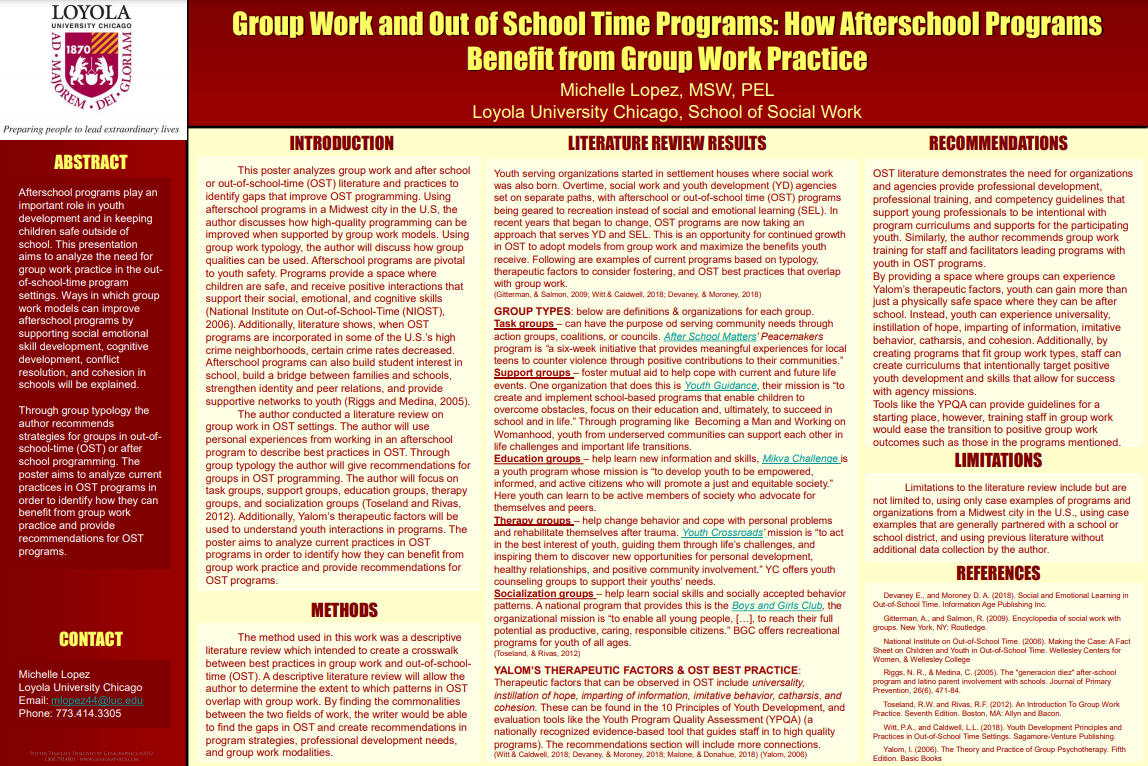Michelle Lopez, Loyola University Chicago, Chicago, IL (USA)
Afterschool programs play an important role in youth development and in keeping children safe outside of school. This presentation aims to analyze the need for and impact of group work practice in the out-of-school-time program setting. Ways in which group work models can improve afterschool programs by supporting social emotional skill development, cognitive development, conflict resolution, and cohesion in schools will be explained.

View PDF of Poster.
Presentation Description:
This poster analyzes literature of group work practice and out-of-school-time (OST) best practices and identifies gaps in the later, in order to improve OST programming. Using various afterschool programs and nonprofits in a Midwest city in the U.S, the author will discuss how high-quality programming with youth can be improved when supported by group work models and modalities. Using each group work typology, the author will discuss how, when, and where these group qualities can be used.Many researchers agree afterschool programs are pivotal to youth safety. In the U.S., the times between 2:00pm and 6:00pm are considered some of the highest risk times for children. However, afterschool programming can provide a space where children are not only safe, but also receiving positive interactions with peers, which can support their social, emotional, and cognitive skills (National Institute on Out-of-School-Time (NIOST), 2006). Additionally, research shows, when OST programs are incorporated in some of the U.S.’s high crime neighborhoods, certain crime rates decreased. Another study showed, afterschool programs can build student interest in school, build a bridge between families and school context, strengthen identity and peer relations, and provide supportive networks to youth (Riggs and Medina, 2005). The author conducted a literature review on programs to demonstrate how group work can be used in an OST setting with youth. Additionally, the author will be using personal experiences from working in an afterschool program nonprofit to describe best practices in the field. By discussing each group typology the author will create recommendations for the types of groups that can be formed in OST programming. The author will focus on (1) task groups, (2) support groups, (3) education groups, (4) therapy groups, and (5) socialization groups (Toseland and Rivas, 2012). Additionally, Yalom’s therapeutic factors of universality, instillation of hope, imparting of information, imitative behavior, catharsis, and cohesion will be used to understand the way youth may interact in OST programming. This poster aims to (1) analyze current practices in OST programming in order to identify how they can benefit from group work practices, (2) provide recommendations to strategies to implement in OST programs, (3) discuss potential areas of research for further improvement of OST programming with group work modalities.
References:
- Gitterman, A., and Salmon, R. (2009). Encyclopedia of social work with groups. New York, NY: Routledge.
- National Institute on Out-of-School Time. (2006). Making the Case: A Fact Sheet on Children and Youth in Out-of-School Time. Wellesley Centers for Women, & Wellesley College
- Riggs, N. R., & Medina, C. (2005). The "generacion diez" after-school program and latino parent involvement with schools. Journal of Primary Prevention, 26(6), 471-84. doi://dx.doi.org.proxy.cc.uic.edu/10.1007/s10935-005-0009-5
- Toseland, R.W. and Rivas, R.F. (2012). An Introduction To Group Work Practice. Seventh Edition. Boston, MA: Allyn and Bacon.
- Yalom, I. (2006). The Theory and Practice of Group Psychotherapy. Fifth Edition. Basic Books

